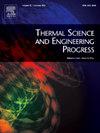Performance improvement and fuel saving by using obstacle in cathode channel of a porous-end PEMFC: A CFD simulation study
IF 5.1
3区 工程技术
Q2 ENERGY & FUELS
引用次数: 0
Abstract
Performance development of polymer electrolyte membrane (PEM) fuel cells has attracted a great attention as clean and affordable energy sources. In the present study, the effect of using a rectangular obstacle in the cathode channel of a porous-end PEMFC was numerically investigated using computational fluid dynamics (CFD) simulation in ANSYS Fluent software. The aim of this work is to utilize the passive method in both anode and cathode channels of a PEMFC to improve the fuel cell efficiency while decreasing hydrogen consumption and pumping power. Hence, the impact of various positions and dimensions of a rectangular obstacle within the cathode channel of a PEMFC is numerically studied. Also, the influence of adding porous media with a specified thickness at the anode channel outlet within a PEMFC is examined. Results show that the presence of an obstacle at h = 0.95 mm and b = 50 mm, along with a porous media of suitable thickness (1 mm), it causes a more uniform dispersion of species and pressure in both channels. Also, results illustrate that increasing the height and distance of the obstacle from the cathode channel inlet of the porous-end PEMFC reduces the pumping power consumption by 93.64 %, while simultaneously maintaining a constant current density. It is indicated by the results that the overall performance of the porous-end PEMFC with the optimal obstacle configuration is enhanced by a factor of 14.31 compared to the Base PEMFC model.
多孔端PEMFC阴极通道中使用障碍物提高性能和节省燃料的CFD模拟研究
聚合物电解质膜(PEM)燃料电池作为一种清洁、经济的能源,其性能的发展备受关注。在ANSYS Fluent软件中,利用计算流体动力学(CFD)模拟,对多孔端PEMFC阴极通道中设置矩形障碍物的影响进行了数值研究。本研究的目的是在PEMFC的阳极和阴极通道中利用无源方法来提高燃料电池的效率,同时降低氢消耗和泵送功率。因此,本文对阴极通道中矩形障碍物的不同位置和尺寸对阴极通道的影响进行了数值研究。此外,还研究了在PEMFC的阳极通道出口添加一定厚度的多孔介质的影响。结果表明,在h = 0.95 mm和b = 50 mm处存在障碍物以及适当厚度(1 mm)的多孔介质,可以使两个通道中物质和压力的分散更加均匀。此外,研究结果还表明,在保持恒定电流密度的同时,增加障碍物距离多孔端PEMFC阴极通道入口的高度和距离可使泵浦功耗降低93.64%。结果表明,最优障碍物配置的多孔端PEMFC的整体性能比基本PEMFC模型提高了14.31倍。
本文章由计算机程序翻译,如有差异,请以英文原文为准。
求助全文
约1分钟内获得全文
求助全文
来源期刊

Thermal Science and Engineering Progress
Chemical Engineering-Fluid Flow and Transfer Processes
CiteScore
7.20
自引率
10.40%
发文量
327
审稿时长
41 days
期刊介绍:
Thermal Science and Engineering Progress (TSEP) publishes original, high-quality research articles that span activities ranging from fundamental scientific research and discussion of the more controversial thermodynamic theories, to developments in thermal engineering that are in many instances examples of the way scientists and engineers are addressing the challenges facing a growing population – smart cities and global warming – maximising thermodynamic efficiencies and minimising all heat losses. It is intended that these will be of current relevance and interest to industry, academia and other practitioners. It is evident that many specialised journals in thermal and, to some extent, in fluid disciplines tend to focus on topics that can be classified as fundamental in nature, or are ‘applied’ and near-market. Thermal Science and Engineering Progress will bridge the gap between these two areas, allowing authors to make an easy choice, should they or a journal editor feel that their papers are ‘out of scope’ when considering other journals. The range of topics covered by Thermal Science and Engineering Progress addresses the rapid rate of development being made in thermal transfer processes as they affect traditional fields, and important growth in the topical research areas of aerospace, thermal biological and medical systems, electronics and nano-technologies, renewable energy systems, food production (including agriculture), and the need to minimise man-made thermal impacts on climate change. Review articles on appropriate topics for TSEP are encouraged, although until TSEP is fully established, these will be limited in number. Before submitting such articles, please contact one of the Editors, or a member of the Editorial Advisory Board with an outline of your proposal and your expertise in the area of your review.
 求助内容:
求助内容: 应助结果提醒方式:
应助结果提醒方式:


